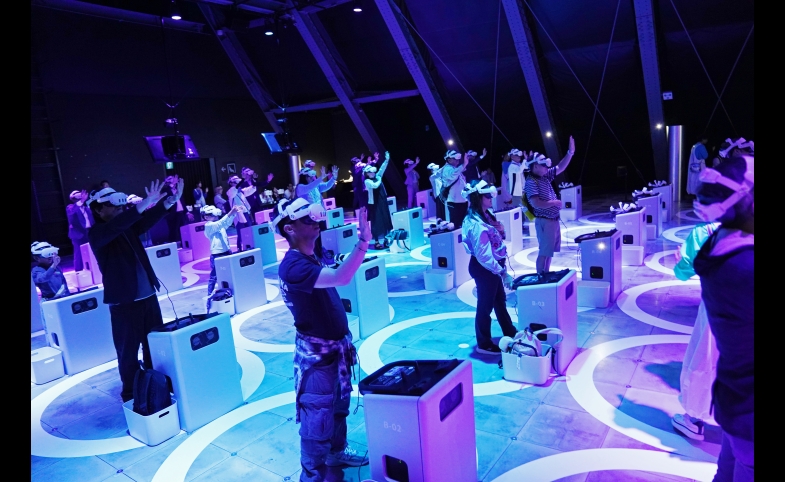With a population of 216 million and a distinct culture of fan fervor, Brazil is a unique region for cultural exchange and diplomacy. American sports teams and entertainers have shown a new dedication to the Brazilian...
KEEP READINGThe CPD Blog is intended to stimulate dialog among scholars and practitioners from around the world in the public diplomacy sphere. The opinions represented here are the authors' own and do not necessarily reflect CPD's views. For blogger guidelines, click here.

Expo 2025 Viewpoints: How Video Games Amplify Japan’s Diplomacy at Expo 2025
This article is part of the CPD Blog series, “Expo 2025 Viewpoints,” featuring essays and photographs by USC Master of Public Diplomacy students who toured the Expo in Osaka, Japan.
At Expo 2025, the games are more than shiny distractions. They form a tight web of reward loops—little jolts of dopamine that pull visitors forward one point with their emotional impact, one badge at a time. Neuroscientist Kelly Clancy calls that a “super-stimulus” in her book, a trick polished over millennia to make the brain lean in and ask for more.
Japan threads its three topics—Saving Lives, Empowering Lives, Connecting the World—through every level. Visitors don’t hear a lecture on carbon footprints. They watch a digital skyline clear when they net a “gas ghost.” Visitors don’t study cooperation in a handbook; they survive a monster raid only by tossing healing items to strangers. Engagement becomes the message, and the message lands because players earn it through video games.
“We are targeting a mostly local audience, with 90% of visitors expected to come from within Japan,” World Expo publicity director Ms. Yoshimura said. Video games were especially prevalent inside the three themed pavilions, which--unlike the national pavilions--are funded by corporations. Organizers of the Gas Pavilion, for instance, designed games for two key groups. First are children around twelve years old, who grasp complex themes more easily through play, echoing Plato’s view that games are vital to civic education.The second group is adults, especially the growing “kidult” demographic that still craves play and self-expression. An Entertainment Software Association 2024 report shows the world’s largest gamer cohort is ages 18 to 35, with an average age of 34—evidence that gaming is now mainstream and cross-generational.
In the Electric Power Pavilion, visitors spot a giant silver egg leaning sideways as if it rolled from a dragon’s nest. It shimmers in daylight and glows at night, earning the nickname “Egg of Possibilities.” A friendly guide hands each person a mini-egg that fits in the palm.
“This is your light, buddy,” she whispers. Inside, the eggshell opens to reveal three areas. In the game zone, guests move between dazzling sites, collect energy from nuclear-fusion atoms beamed by projectors, chase a moon on wall-size screens to gather tidal power and step on vibration plates to defeat on-screen monsters. Each new energy source makes the mini-eggs flash a different color.
Next, the lights drop and music booms. Every child’s egg blinks in perfect sync, like a thousand fireflies. A final wall then shows the powers collected and green energy generation methods in the real world that are analogous to different game modes. People leave cradling the glowing tokens, dreaming of the clean, bright future they helped hatch.
"Expo 2025 drip-feeds visitors a steady rush of affirmation, scratching humanity’s built-in itch for validation. These aren’t just games—they’re nation-backed muscle-memory diplomacy, engineered to linger long after the controller clicks off....Together, they create an emotional surround-sound that lets guests absorb a country’s story without ever feeling lectured, still the gold standard for public diplomacy work."
At the Gas Pavilion, a neon sign reads “Bakeru — Shape Our Future!”, sponsored by over 200 Japanese gas corporations. A guide fits visitors with Bakeru XR goggles and, in an instant, playful OBAKE ghosts swirl into view. The floor becomes a giant XR jungle gym. When visitors tag a drifting cloud ghost. it flares into a blue e-methane flame. Or, they can stretch out their hands to fire sapphire beams at a towering CO2 monster. When the blue beam slams the target and its health bar nosedives, a surge of accomplishment lights up each player’s face. Around them, fellow guests—rendered as "OBAKE allies"—fire in sync, creating a sense of belonging. Together visitors topple the carbon titan, even as it growls that greed could raise it again. For now, teamwork tilts Earth’s fate toward hope, and the goggles flash a victory badge to prove it.
As the monster crashes with a thunderous roar, shoulders around the arena relax. The title of “Earth Guardian” brings a quiet wave of pride—glory earned through effort. The beast’s warning, “Don’t be greedy, or I’ll return,” plants a seed of vigilance. The layered emotions feel like a quick shot of energy for mind and heart, showing that protecting the planet can be both fun and personal. Visitors stamp their passports with hope and optimism—proof they helped the future by transforming today.
In the Healthcare Pavilion, themed "Nest for Reborn," Tsubakimoto Chain’s “Body Enhancement Suit” straps guests into a feather-light exoskeleton. An XR dash through virtual skies records speed, balance and lifting power, then prints a “made-to-measure robot” report. The content creators want guests to feel bionic, not intimidated. The rush of flight triggers joy and amazement—emotions that anchor long-term memory, according to Norbert Schwarz’s research.
Nearby, dairy giant Morinaga invites families to “Become a Superhuman with Bifidobacteria.” In one game, a face-scan brick-breaker widens the on-screen paddle when players smile—illustrating how gut flora can enhance skin health. In another, seniors shake bacteria-shaped sticks to test their “longevity power.” When virtual cancer cells attack, a haptic waist belt rumbles in response—a sensory cue that creates quick emotional feedback and, as psychologists note, helps hard-wire hope.
Nippon Life’s “Reborn 2025” turns Osaka in 2050 into a life-size Monopoly. Up to 22 strangers spin a digital wheel, debate health and career choices, and watch LED skylines brighten or dim. The blend of anticipation, cooperation and pride is logged by the game system, which displays a final score balancing coins and hearts.
Finally, Capcom’s “Monster Hunter Bridge” drops guests into a 360-degree AR arena that shakes when a lava dragon lands. Only teamwork—sharing herbs and flash bombs—can kill the beast.
“The word ‘Bridge’ represents connection," said the Capcom president Tsujimoto. "It means digital and reality world are connected. We’re sharing joy together, even with guests from other countries. That sense of connection is what makes it truly special."
In a world starved for real-life rewards, Expo 2025 drip-feeds visitors a steady rush of affirmation, scratching humanity’s built-in itch for validation. These aren’t just games—they’re nation-backed muscle-memory diplomacy, engineered to linger long after the controller clicks off. Joy, trust, surprise, hope—none of these emotions fires in isolation. Together, they create an emotional surround-sound that lets guests absorb a country’s story without ever feeling lectured, still the gold standard for public diplomacy work.
While these pavilion games borrow familiar mechanics from commercial video games—levels, reward systems, and team play—they are designed with diplomatic outcomes in mind, showing a unique use case that diverges from entertainment-first models.
The universal architecture of games runs on customized rules that reward players who obey the rules and penalize those who don’t. The rules set decide whether cooperation or competition wins the day, whether honesty is trusted or cheating is exposed. By practicing within that system, players internalize its values instead of being told what to believe, exactly the mechanism public diplomacy relies on to scale a norm.
Because modern play spaces run on real-world data and algorithmic feedback, a sandbox can now model anything from a single life path—career, family, health—to the macro arcs of economies, alliances, even conflict scenarios. Tweak the inputs, watch futures branch, return to reality armed with clearer next steps. And because mechanics beat language barriers, these systems open fresh cognitive windows for cross-cultural exchange.
When a visitor in Osaka spins up a digital wind turbine or fights with greenhouse gas, those universal mechanics and special uses fuse into one persuasive loop. The dopamine spike feels personal, but the takeaway is collective: the path forward is green, cooperative, and—more than ever—gamified.
Visit CPD's Online Library
Explore CPD's vast online database featuring the latest books, articles, speeches and information on international organizations dedicated to public diplomacy.
POPULAR ARTICLES
-
November 3
-
November 5
-
November 13
-
October 16
-
October 16
Join the Conversation
Interested in contributing to the CPD Blog? We welcome your posts. Read our guidelines and find out how you can submit blogs and photo essays >.













